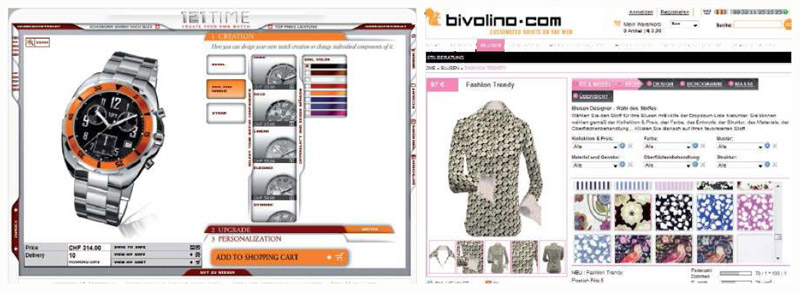The Customization500 study (see Part 2 of this series) provided us very detailed view into the current practice of choice navigation and online configuration. We used five key evaluation criteria to evaluate the configuration toolkits in our sample: (1) visual realism, (2) usability, (3) creativity, (4) enjoyment and (5) uniqueness.
All impressions were measured by our panel of trained expert judges on a 1 to 5 rating scale (1=very low value / 5=very high value). For most of these criteria, we used multiple items to gather the scope of these criteria. Items were grouped and tested with the help of factor and reliability analysis. Inter-rater reliability of these factors was checked with the Intra- Class-Correlation-Coefficient. Finally, the single factors were combined to one overall factor.
Drivers of customer satisfaction with a choice navigation toolkit
This is how we measured the performance of the toolkits:
- Visual Realism was measured by means of one question “How realistic do you assess the visualization of the configuration process?”
- To measure usability, the evaluators were asked to rate: The configurator is (1) intuitively usable, (2) user-friendly as well as (3) clearly and (4) logically structured.
- The creativity factor consists of the two items: (1) The website gave me a lot of freedom, and (2) Icould give my creativity free rein while designing the product.
- To determine enjoyment, the experts had to rate: The configuration was (1) fun, (2) delight, (3) pleasure, (4) entertaining and (5) interesting.
- To assess uniqueness following statements had to be evaluated: My created product (1) is unique, (2) is different, (3) helps me to differentiate; and (4) no one else has such a product.
…about 50 percent of the additional willingness to pay can be explained by the process experience…
Our analysis showed that on the one hand, “preference fit” and the meeting of a customer’s “need for uniqueness” are strong drivers of satisfaction with a particular mass customization offering. However, process satisfaction, resulting from the enjoyment and creative evolvement during a user-friendly configuration process, has an even higher impact in many cases, according to our data. This confirms the early findings of researchers like Nikolaus Franke, Martin Schreier, or Frank Piller who have stated that in B2C mass customization about 50 percent of the additional willingness to pay can be explained by the process experience and a feeling of achievement and co-design success – and not by the higher functionality of fit of a custom product. Our study clearly supports this claim. We urge managers to look beyond the sheer technology and back office integration of configuration toolkits and also focus on delivering a great configuration experience.
When crunching the numbers, we found a large puzzle: The reality of toolkits clearly falls behind the broad body of academic research on design parameters of successful toolkits, as outlined in the last article (Part 5). Here are some of our core observations:
Meaningful visualization
Academic research often has stressed the importance of realistic visualization as a core element of a good toolkit. But many companies in practice still have very simple visualization features, and sometimes no illustration of the outcome at all. But there also can be too much of a good thing: evaluators often highlighted not those sites with the most advanced 3D visualization as best in class, but those with visualization features that matter and come to the point.
For many products, a realistic, fast, plug-in free and well-described visual of an individual configuration is better than a complicated 3D model wearing, for example, my custom T-shirt – that takes many seconds to load and almost crushed my computer when playing with it. Sounds obvious? Well, it is not. We still see many sites where technology is used as a point of differentiation – but not as a source of customer value!
Providing help and process navigation
When looking at the data which features of a configurator drive most the perceived usability and use experience, we found that navigation- and orientation-help features, such as a progress bar or an activity list, play a key role. Co-design toolkits with a higher level of company- and/or customer-help features, such as design inspirations, deeper product information or recommendations by other consumers, in general performed better in terms of satisfaction. However, about 50% of the toolkits in the “Customization 500” do not offer any or only a low level of these features. Here, we find many untapped opportunities for practice to enhance the gross utility of customers.
Companies should “customize their mass customization strategy” based on the requirements of their customer stock.
However, we’ve found quite a few offerings without or with only a low level of these features which were performing excellently nonetheless. In some cases, the simple product design (solution space) did not require special help features. In other cases, customer satisfaction with the offerings was excessively influenced by the particular value provided by the customizable product itself. There is not one best way. Companies should “customize their mass customization strategy” based on the requirements of their customer stock. But having an understanding of the perception of customers or a firm’s toolkit is crucial to make such a decision.
Parameter versus need based configurators
The largest gap between practice and recommendations of academic research can be found in the area of parameter- versus need-based toolkits. We found that in today’s mass customization reality, basic parameter (option) based toolkits still rule. Customers have to make their own decisions from a list of predefined options. This often demands a large number of decisions and also knowledge of the user about the product. While this may be perfect in the business-to-business context, it is not always the best option in consumer markets.
A need-based configurator hence mimics the behavior of a good sales person who also may recommend you exactly the right product…
Here, need-based configuration has been shown to provide better results. In such a need-based system, users share something about their preferences, requirements, or expected outcomes. This input then is transferred by an algorithm into a product configuration. A need-based configurator hence mimics the behavior of a good sales person who also may recommend you exactly the right product (configuration) after asking just a few but insightful questions. In our study of the best 500 toolkits, less than 3% of companies had such a need-based configurator in place. While we acknowledge that it is more costly to develop a good need-based configurator, these systems seem to offer a great opportunity for differentiation and larger customer satisfaction.
Concluding, we can state that mass customization still is an area in the making. While there has been much progress, and there are some really great toolkits in the market, the majority of systems still is in an early stage. But as our data shows, from the customer perspective it often is just a small step between a good to a great toolkit.
By Dominik Walcher & Frank Piller
About the authors
 Frank Piller is a chair professor of management and the director of the Technology & Innovation Management Group at RWTH Aachen University. He also is a founding faculty member and the co-director of the MIT Smart Customization Group at the Massachusetts Institute of Technology, USA. Frequently quoted in The New York Times, The Economist, and Business Week, amongst others, Frank is regarded as one of the leading experts on mass customization, personalization, and open innovation. Frank’s recent research focuses on innovation interfaces: How can organizations increase innovation success by designing and managing better interfaces within their organization and with external actors.
Frank Piller is a chair professor of management and the director of the Technology & Innovation Management Group at RWTH Aachen University. He also is a founding faculty member and the co-director of the MIT Smart Customization Group at the Massachusetts Institute of Technology, USA. Frequently quoted in The New York Times, The Economist, and Business Week, amongst others, Frank is regarded as one of the leading experts on mass customization, personalization, and open innovation. Frank’s recent research focuses on innovation interfaces: How can organizations increase innovation success by designing and managing better interfaces within their organization and with external actors.
Email: piller@mass-customization.de
mass-customization.blogs.com
 Dominik Walcher is professor for marketing and innovation management at Salzburg University of Applied Sciences / School for Design and Product Management. He studied architecture and management at the University of Stuttgart, the Technical University Munich (TUM), and the University of California at Berkeley. His doctoral thesis about mass customization and ideation contests was awarded with several prizes. In the last years, he has extended his field of research to brand management, business creation and sustainability marketing. He was a co-founder of a startup company in the field of customizable and eco-intelligent products.
Dominik Walcher is professor for marketing and innovation management at Salzburg University of Applied Sciences / School for Design and Product Management. He studied architecture and management at the University of Stuttgart, the Technical University Munich (TUM), and the University of California at Berkeley. His doctoral thesis about mass customization and ideation contests was awarded with several prizes. In the last years, he has extended his field of research to brand management, business creation and sustainability marketing. He was a co-founder of a startup company in the field of customizable and eco-intelligent products.
Email: walcher@mc-500.com
www.mc-500.com
Upcoming articles in this series:
Introduction: A special series of articles on mass customization and customer co-design
Part 1: Competing in the Age of Mass Customization
Part 2: The market for mass customization today
Part 3: Solution Space Development: Understanding where customers are different
Part 4: Robust Process Design: Fulfilling individual customer needs without compromising performance
Part 5: Choice Navigation: Turning burden of choice into an experience
→ Part 6: Choice Navigation in Reality: A closer look into the Customization500
Part 7: Overcoming the Challenges of Implementing Mass Customization
Part 8: A Balanced View: Conclusions and Key Learnings









